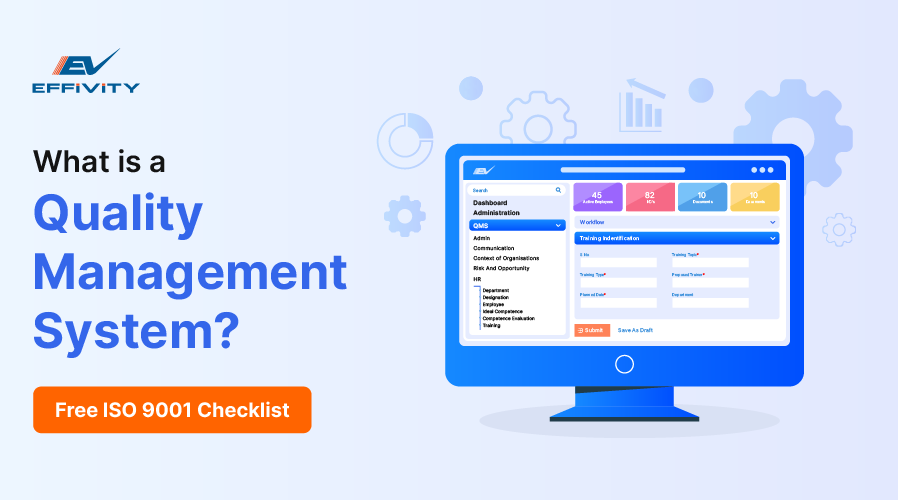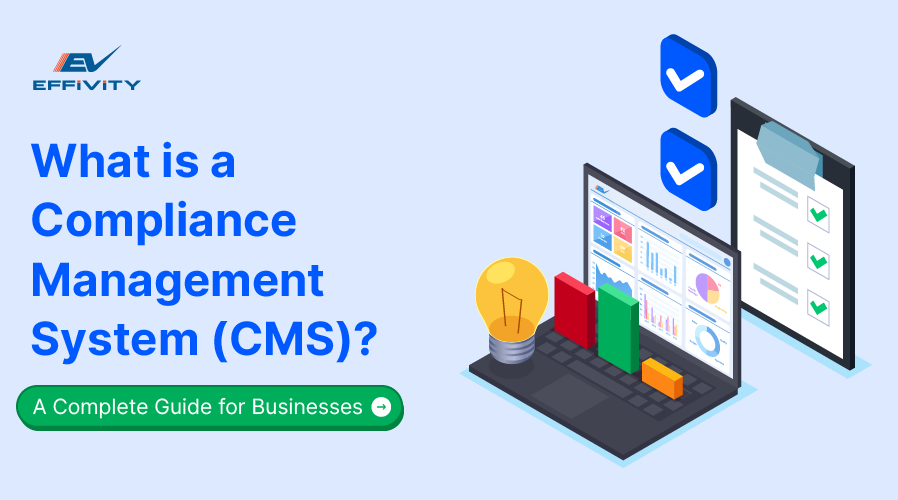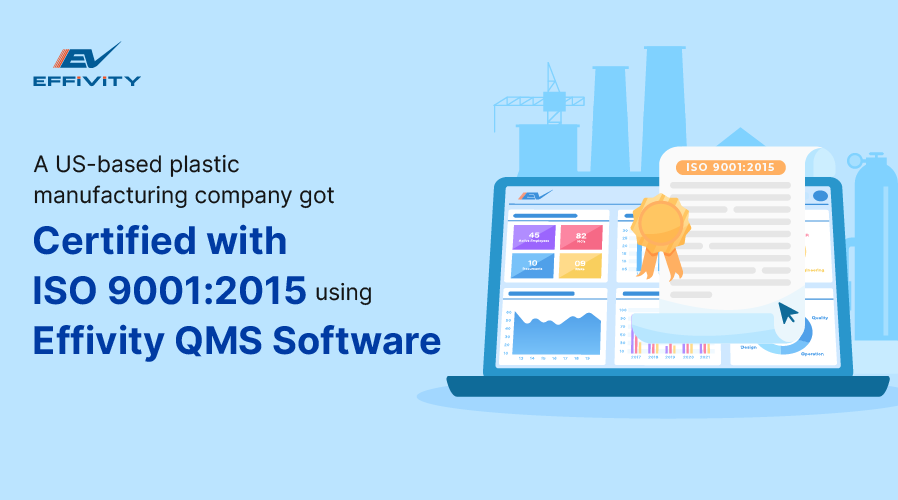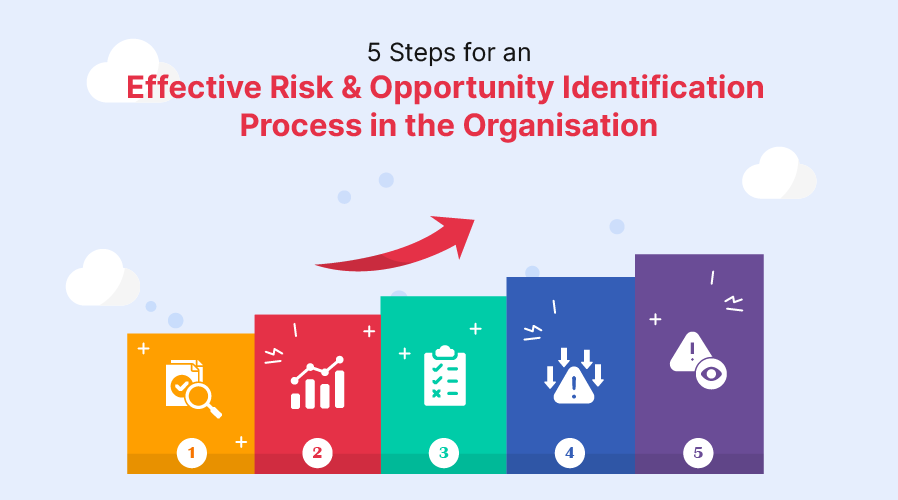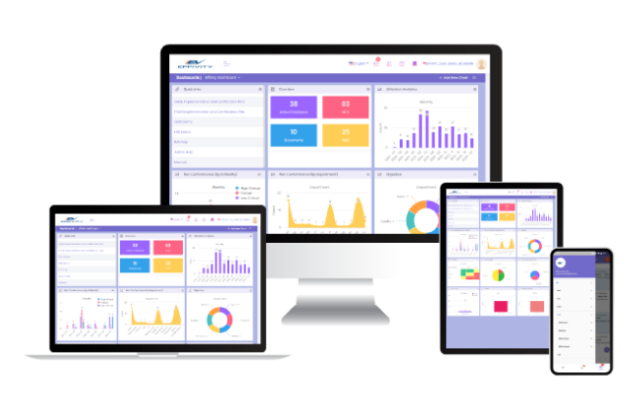As global regulations evolve into integrated and outcome-based frameworks, businesses are expected to align their IT processes with recognised standards like ISO 9001 or ISO 27001. These ISO frameworks help businesses boost product quality, cut back on resources and be prepared for auditing, all while streamlining their business operations.
However, compliance with these standards is more than just paperwork, it demands strategy and real-time execution.
This article explores the operational gaps that weaken IT compliance management and outlines a structured and scalable path.
What is IT Compliance?
IT regulatory compliance refers to the process of adhering to a defined set of privacy and IT-related security checks and protocols to ensure the safety and security of customer data collected, stored and processed by an organisation’s IT systems. This acts as a preventive measure against data breaches and cyber threats.
Strong IT compliance management ensures the organisation's audit-readiness, while also supporting smooth execution and mitigating security risks. On top of that, having a custom IT compliance strategy supports cross-team functionality, elevates brand credibility and allows sustained scaling. Aligning with IT compliance checks that help with being audit-ready by supporting cybersecurity compliance systems.
What are the Types of IT Compliance?
Below are the most widely followed frameworks that standardise IT operations to safeguard consumer data:
1. ISO/IEC 27001: Globally recognised standard for Information Security Management Systems (ISMS) to identify IT risks and implement secure policies.
2. HIPAA: Applies to the US healthcare sector and is a mandatory standard to uphold and comply with for safeguarding Protected Health Information (PIH).
3. GDPR: Relevant to businesses involved in collecting, storing and using data of individuals under the European Union (EU).
4. DPDP Act: Stands for Digital Personal Data Protection Act and applies to Indian businesses handling user data to ensure user consent, breach reporting and lawful data processing.
A well-planned compliance management system ensures meeting these standards for audit, while also helping recognise internal bottlenecks in time.
The Importance of an IT Compliance Strategy
An IT compliance strategy helps in accomplishing more than just regulatory functions. It helps by building a structured foundation that helps with business performance, long-term growth and managing risks. Here are the most significant contributions:
1. Safeguards Sensitive Information
An IT compliance strategy ensures the data protection protocols are being enforced across systems to prevent breaches, privacy violations and to help with IT Compliance management.
2. Reduces Legal and Financial Risk
Non-compliance can cost millions in penalties owing to high fines levied by GDPR and HIPAA. Breaches due to non-compliance can also lead to lawsuits, audit issues and lack of credibility.
3. Builds Credibility and Customer Trust
Clients trust businesses that are able protect their data privacy and integrity. Customer retention and loyalty are always crucial to IT-related businesses.
4. Improves Operational Efficiency Internally
Organised workflows and access granted on the basis of roles helps in reducing manual errors which simplify routine processes. Staying prepared for audits also aids with spotting inefficiencies internally.
5. Strengthens Security Systems
Compliance frameworks allow organisations to catch and fix security and privacy issues at an early stage. These controls can also be automated using software designed to eliminate such errors and risks.
6. Supports Scale and Standardisation
A consistent IT compliance framework helps in enforcing uniform processes across different locations, teams and systems. Certain systems also help by creating a single dashboard for all teams.
What Do Most IT Compliance Strategies Miss?
Most organisations have IT governance and compliance in place like policies, access controls and training modules. However, they can still miss following regulations while executing. It takes control, planning, structure and accountability when it comes to running operations.
The commonly overlooked areas of IT compliance are:
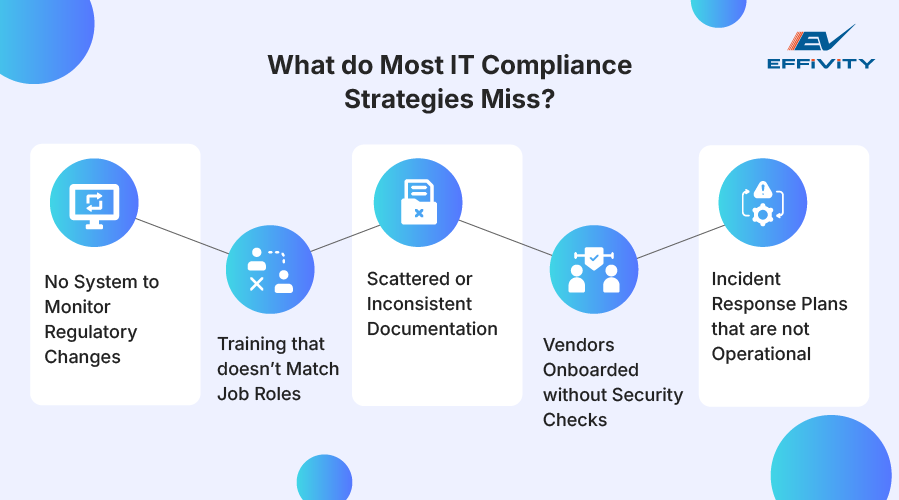
1. No system to monitor regulatory changes
When teams do not track updates to laws or standards it becomes difficult to track the changes in policies. Thus, the implementation part also starts lagging behind.
2. Training that doesn’t match job roles
When all teams get the same module, technical teams do not receive ample training to allow them to deal with system-level risks. This results in lack of awareness, low coverage and no real crisis management plan.
3. Scattered or inconsistent documentation
Policies, logs and approvals are stored in disconnected folders and inboxes. Without a central system, there is no way to confirm what is current and valid. Audit teams end up wasting time chasing conflicting records.
4. Incident response plans that are not operational
Most teams have a dedicated response plan ready, but when it is rarely tested, the escalation paths can be unclear, with scattered ownership. This can cause operational issues. In most cases, ISO 9001 compliance goes hand-in-hand with compliance automation systems by establishing clear steps, roles and logs.
How to Manage IT Compliance Effectively
A strategy acts as a roadmap to fulfil compliance needs together without being a single-time audit checklist. If you want your IT compliance management efforts to work in real time, you need to scale across teams and clear audits. This requires a clear understanding of how to manage IT compliance in practicality and not just on paperwork.
Follow these steps to lay the successful groundwork:
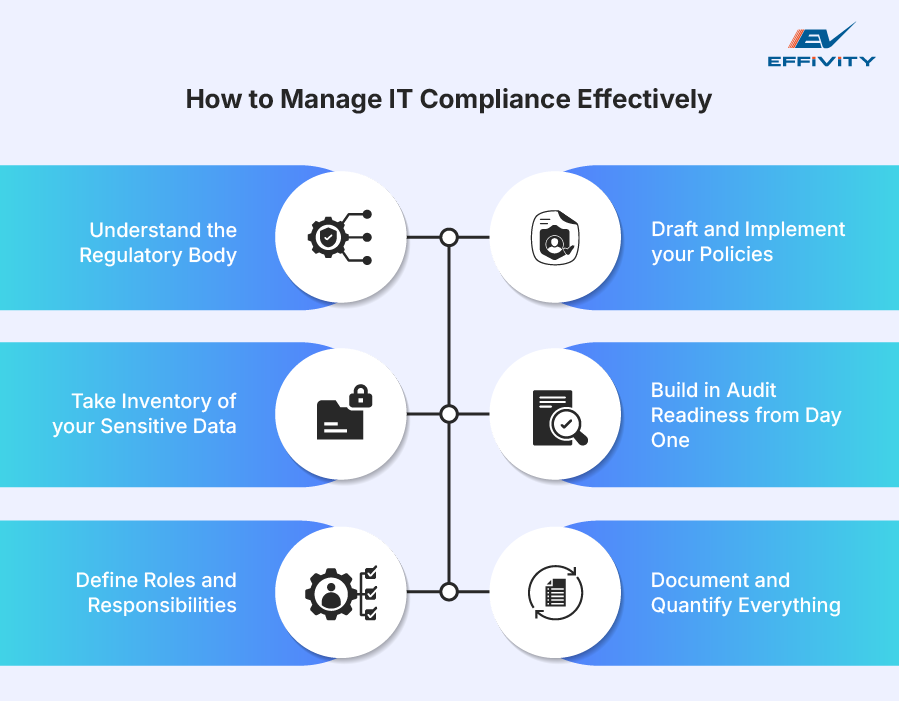
1. Understand the Standard to be Upheld
Start by understanding the laws, standards and policies that apply to your business. This includes standards like ISO, GDPR, HIPAA, or India’s DPDP Act.
2. Take Inventory of Your Sensitive Data
Identify where personal and sensitive data is stored and who handles it. Risk assessment and a compliance checklist are the initial steps towards passing an audit.
3. Define Roles and Responsibilities
Every team that deals with client data is as responsible as the IT team. You can assign leads within teams to focus on areas like security, legal and data handling.
4. Draft and Implement Your Policies
Create an actionable plan for data handling, granting access, vendor risk and more. The Ponemon Institute found that employee negligence was the reason behind 55% of data breaches in 2023.
5. Build in Audit Readiness from Day One
Maintain regular records of edits, policy updates, incidents and approvals. Auditors want evidence of valid logs and documentation that are also consistent. You can start by using a compliance management system to ease this step.
6. Document and Quantify Everything
Store your approved and implemented policies, logs, audit results, approvals and risk registers in a single centralised system. Audits can become difficult to clear if these are not fully documented.
These steps become simpler by using a framework specifically aligned to ISO 9001 to automate and integrate roles, logs and documentation under a single compliance system.
IT Compliance Checklist
Here’s a checklist for businesses to effortlessly comply with IT compliance regulations:
- Identify standards to aim for (ISO 9001, DPDP, GDPR and more)
- Assign department-wise duties for compliance
- Maintain logs and records for policies and updates
- Create training modules depending on departments and job roles
- Set alerts and deadlines for changes in regulations
- Track ownership access and edits activity
- Archive past regulations and necessary documentation
- Schedule internal audits regularly
Checklist to Execution with Effivity
From audit readiness to risk-management, businesses must frame their strategies to align with the right types of compliance, whether it is operational, regulatory or contractual. Most organisations already have their IT compliance checklists in place. The challenge is turning those policies into systems that hold up in real operations. Without structure, ownership and clear documentation, even well-intended strategies break down under pressure. A working compliance strategy connects documentation with execution. It creates visibility, enforces accountability and removes the guesswork from audits.
Effivity supports this by offering a single platform to manage controls, align with ISO standards and maintain audit-ready records across teams and locations. To see how Effivity helps you simplifies how to manage IT compliance at scale. Visit Effivity to learn more.

